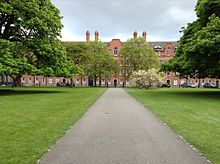
Trinity College is a constituent college of the University of Cambridge. Founded in 1546 by King Henry VIII, Trinity is one of the largest Cambridge colleges, with the largest financial endowment of any Oxbridge college. It is the largest Oxbridge college measured by the number of undergraduates (730). Trinity performs exceptionally as measured by the Tompkins Table, coming top from 2011 to 2017. Trinity was the top-performing college for the 2020–21 undergraduate exams, obtaining the highest percentage of good honours.

St John's College, formally the College of St John the Evangelist in the University of Cambridge, is a constituent college of the University of Cambridge, founded by the Tudor matriarch Lady Margaret Beaufort. In constitutional terms, the college is a charitable corporation established by a charter dated 9 April 1511. The aims of the college, as specified by its statutes, are the promotion of education, religion, learning and research. It is one of the largest Oxbridge colleges in terms of student numbers. For 2022, St John's was ranked 6th of 29 colleges in the Tompkins Table with over 35 per cent of its students earning first-class honours. It is the second wealthiest college in Oxford and Cambridge, after its neighbour Trinity College, Cambridge.

Lady Margaret Hall (LMH) is one of the constituent colleges of the University of Oxford in England, located on a bank of the River Cherwell at Norham Gardens in north Oxford and adjacent to the University Parks. The college is more formally known under its current royal charter as "The Principal and Fellows of the College of the Lady Margaret in the University of Oxford".

Trinity College is one of the constituent colleges of the University of Oxford in England. The college was founded in 1555 by Sir Thomas Pope, on land previously occupied by Durham College, home to Benedictine monks from Durham Cathedral.

Trinity College Dublin, officially titled The College of the Holy and Undivided Trinity of Queen Elizabeth near Dublin, is the sole constituent college of the University of Dublin, Ireland. Founded in early 1592 by Queen Elizabeth I who issued a royal charter, it is Ireland's oldest university and was modelled after the collegiate universities of both Oxford and Cambridge. Named after The Holy Trinity, the epithets "Trinity College Dublin" and "University of Dublin" are usually synonymous for administrative purposes, as only one such college was ever established.
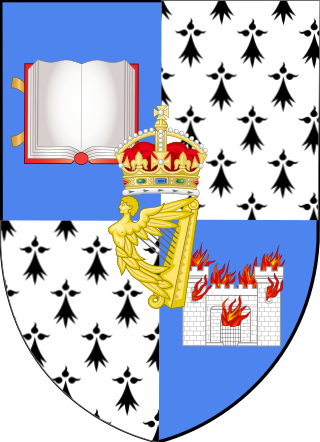
The University of Dublin, corporately designated as the Chancellor, Doctors and Masters of the University of Dublin, is a research university located in Dublin, Ireland. It is the degree-awarding body for Trinity College Dublin. It was founded in 1592 when Queen Elizabeth I issued a royal charter for Trinity College as "the mother of a university", thereby making it Ireland's oldest operating university. It was modelled after the collegiate universities of Oxford and Cambridge, but unlike these affiliated ancient universities, only one college was ever established; as such, the designations "Trinity College Dublin" and "University of Dublin" are usually synonymous for practical purposes.

Selwyn College, Cambridge is a constituent college of the University of Cambridge. The college was founded in 1882 by the Selwyn Memorial Committee in memory of George Augustus Selwyn (1809–1878), the first Bishop of New Zealand (1841–1868), and subsequently Bishop of Lichfield (1868–1878). Its main buildings consist of three courts built of stone and brick. There are several secondary buildings, including adjacent townhouses and lodges serving as student hostels on Grange Road, West Road and Sidgwick Avenue. The college has some 60 fellows and 110 non-academic staff.

Corpus Christi College is a constituent college of the University of Cambridge. From the late 14th century to the early 19th century it was also commonly known as St Benet's College.

Queens' College is a constituent college of the University of Cambridge. Queens' is one of the 16 "old colleges" of the university, founded in 1448 by Margaret of Anjou. Its buildings span the River Cam with the Mathematical Bridge and Silver Street connecting the two sides.
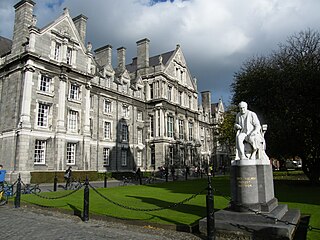
The Graduates Memorial Building (GMB) is a neo-Gothic Victorian building, in Trinity College Dublin designed by Sir Thomas Drew in 1897. It is home to Trinity College's oldest student societies: the University Philosophical Society, the College Historical Society and the College Theological Society.
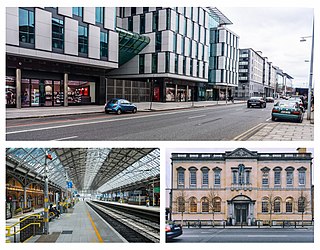
Pearse Street is a major street in Dublin. It runs from College Street in the west to MacMahon Bridge in the east, and is one of the city's longest streets. It has several different types of residential and commercial property along its length.
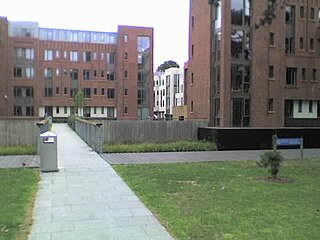
Trinity Hall is the main extramural hall of residence for students of Trinity College in Dublin, Ireland. It is located on Dartry Road in the Dartry neighbourhood, part of the affluent suburb of Rathmines and about 4 kilometres south of the College's main campus. Trinity's Botanic Gardens share the site. Trinity Hall is linked to the city centre campus by direct Dublin Bus route and the Luas light rail system via the Milltown Luas stop.

A common room is a group into which students are organised in some universities, particularly in the United Kingdom, normally in a subdivision of the university such as a college or hall of residence, in addition to an institution-wide students' union. They represent their members within the hall or college, operate certain services within these institutions such as laundry or recreation, and provide opportunities for socialising. There are variations based on institutional tradition and needs, but classically the following common rooms will exist:

The School of Medicine at Trinity College in Dublin, Republic of Ireland, is the oldest medical school in Ireland. Founded in the early eighteenth century, it was originally situated at the site of the current Berkeley Library. As well as providing an undergraduate degree in medicine, the school provides undergraduate courses in physiotherapy, occupational therapy, radiation therapy, human nutrition & dietetics and human health & disease, over 20 taught postgraduate courses, and research degrees.

The Royal Victoria Eye and Ear Hospital is a public teaching hospital in Dublin, Ireland. The Royal Victoria Eye and Ear Hospital in Dublin was founded in 1895 and is the National Referral Centre for both Eye and Ear, Nose & Throat disorders.

Academic dress prescribed at the Trinity College Dublin follows a relatively complex protocol which, nonetheless, shares some particular characteristics with other universities in Ireland and with its sister institutions at the University of Oxford and University of Cambridge in the United Kingdom.

Gonville and Caius College, often referred to simply as Caius, is a constituent college of the University of Cambridge in Cambridge, England. Founded in 1348 by Edmund Gonville, it is the fourth-oldest of the University of Cambridge's 31 colleges and one of the wealthiest. In 1557, it was refounded by John Caius, an alumnus and English physician.

The Campanile of Trinity College Dublin is a bell tower and one of its most iconic landmarks. Donated by then Archbishop of Armagh, Lord John Beresford it was designed by Sir Charles Lanyon, sculpted by Thomas Kirk and finished in 1853.

The Printing House is a classical Palladian style temple building that was constructed within the campus of Trinity College Dublin around 1734 under the tenure of provost Richard Baldwin.
